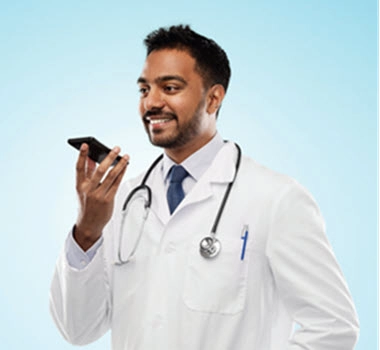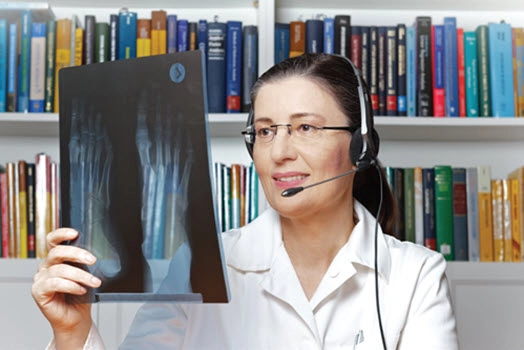Skip the home row and pick up a microphone.
When healthcare providers need to complete their clinical documentation, more of them are reaching for a microphone, rather than the keyboard. Doctors of the past may have used a voice recorder and a transcription service, but now physicians can dictate their notes into a USB microphone and see their words appear onscreen.
Learn how speech recognition software is saving clinicians time and allowing them to produce clearer and more detailed medical documentation.

Save Documentation Time by Speaking
Speech recognition software is growing in popularity and use by healthcare providers to complete documentation in electronic medical records (EMRs) and electronic health records (EHRs). The software identifies spoken words and creates readable medical documentation.
Christopher J. Norman, MSN, APRN, GNP-BC, geriatric nurse practitioner for PACE CNY (Program of All-inclusive Care for the Elderly of Central NY) in East Syracuse, New York has used speech recognition software for several years. “I use speech recognition software for clinical documentation after face-to-face encounters with patients,” Norman says.
He adds that one of the biggest advantages of using the software is the amount of time it has saved him while documenting visits. “The ability to dictate my clinical documentation has saved me tens of hours in after-encounter documentation,” Norman continues. Documenting visits with patients isn’t easy during appointments, so having the technology to quickly and accurately document visits helps Norman complete his work by the end of his clinic day instead of taking it home with him or adding it to a to-do pile of backlogged documentation.
Healthcare organizations are offering the software to help ease the burden of their clinicians’ documentation responsibilities. “We started offering the software to physicians who want to use it, and two camps were very interested — the techie doctors who love new technology, and then the doctors who are really struggling with typing,” says Allen Hsiao, MD, FAAP, FAMIA, chief health information officer, professor of pediatrics and emergency medicine, interim chief of pediatric emergency medicine, Yale New Haven Health and Yale School of Medicine in New Haven, Connecticut.
Dr. Hsiao adds that some of the latter doctors may have also been using “partial dictation” or “the old-fashioned transcription services.” These doctors’ switch to the speech recognition software may be due to the slow turnaround time of the transcription or just a desire to try something different. As a result, “almost universally everyone loved the software,” Dr. Hsiao says, and currently, around 1,200 doctors use the speech-recognition software every day at Yale.
Dr. Hsiao’s curiosity about the software led him to write better notes. “When we first launched it, I started playing with it just so that I could speak to the technology. Even though I type very fast, I found that I liked the software, too, because I felt I wrote better notes. The process helped me with my thinking of the differential diagnosis, and I would put more content in my notes than if I were just typing,” Dr. Hsiao says.
A 2020 study conducted at the Brigham and Women’s Hospital in Boston examined the usability of speech recognition software against typing. Researchers found that dictated notes were longer and contained more distinctive words “than typed notes.” Additionally, the study found that dictated notes took “slightly less time to complete than typed notes,” and the typed notes contained more uncorrected errors.
Master Medical Jargon
Early versions of the software technology had issues with specific medical terms, and this became evident as the COVID-19 public health emergency (PHE) took hold. Users of popular speech recognition software had to quickly act to correct errors in their records following dictation. “The software rarely recognized ‘COVID-19.’ That got problematic in a hurry as cases started popping up everywhere,” Norman says.
Luckily, the top software in the industry, such as Nuance’s Dragon and 3M’s M*Modal, have made significant strides in staying up to date with medical terminology. The software is designed to understand medical documentation and doesn’t substitute several non-layman terms by accident.
For example, if the provider is discussing a patient’s abdominal pain and says the word “intussusception,” the software can recognize that term in relation to the subject matter and won’t substitute a similar-sounding word, such as suction or section. “Even if my voice wasn’t the clearest, it’s going to do a good job at guessing ‘intussusception’ because I was also talking about appendicitis, volvulus, and other medical diagnoses that sort of fit together in the context of abdominal pain,” Dr. Hsiao explains.
However, as accurate as the software currently is, the need for human review remains. If you used the speech-to-text function on your smartphone to write a text message, you may find misspellings, incorrect words, or missing punctuation. If you extrapolate that to a highly technical document such as a medical record, you may find more errors or mistakes that carry greater consequences.
Scenario: A provider is dictating their encounter and a person nearby coughed at the exact moment the provider spoke a prescription of “10 milligrams of atenolol,” but the software recorded it as “10 grams.” If a human being doesn’t review the record, the patient could receive a dangerous dose of their medication.
“I am fortunate that our health information management folks complete grammar checks on all our clinical documentation,” Norman says.

Seeking the ‘Holy Grail’
An ideal situation, or the “holy grail” of medical documentation as Dr. Hsiao puts it, would be for the computer to listen to the encounter in real-time, filter out background noise, write a complete note, and perform other tasks. While years away from actuality, this ambient intelligence would provide a hands-free way for clinicians to complete their documentation and attend to their patients without ever touching the keyboard during a session.
Presently, healthcare professionals can use speech recognition software to tackle their clinical documentation responsibilities without a second thought. Much like the stethoscope became an invaluable tool for clinicians to do their jobs, speech recognition software can help transform an EHR into an equally valuable tool that will allow healthcare providers to concentrate on the patient and then compile detailed notes, analyze diagnoses, and explore treatment recommendations after the visit.
